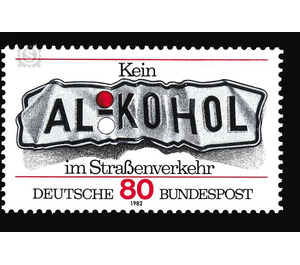No alcohol in traffic - Germany / Federal Republic of Germany 1982 - 80 Pfennig
Theme: Post & Philately
| Country | Germany / Federal Republic of Germany |
| Issue Date | 1982 |
| Face Value | 80.00 |
| Color | black white |
| Perforation | K 14:14 1/4 |
| Printing Type | 4-color rotogravure |
| Stamp Type | Postage stamp |
| Item Type | Stamp |
| Chronological Issue Number | 1018 |
| Chronological Chapter | GER-BRD |
| SID | 498587 |
| In 60 Wishlists | |
The issue of the special stamp should help to inform the public about this serious problem. It is the continuation of the series of current topics. For the year 1980, the official accident statistics show that at 45,554 of the 379,235 accidents involving personal injury a driver had caused the accident under the influence of alcohol. In these alcohol accidents, 2,534 people were killed, 25,527 were severely injured and 39,006 were slightly injured. One of the main aims of all efforts to improve road safety must therefore be to spread the knowledge that even small amounts of alcohol, and in no way even the limit of 0.8 per thousand, can substantially reduce the ability to drive safely. Motorists should be given the insight in every possible way that alcohol consumption and driving are fundamentally incompatible. The individual can already be far from driving under the 0.8-thousand-franc limit, so according to supreme court case law already at 0.3 per thousand. The inability to drive depends not only on the amount of alcohol, but also on many individual subjective factors. A rule that applies to all people and that applies at all times and takes into account every physical and mental condition as well as all other significant circumstances does not exist. From scientific studies it is known that even at low alcohol concentrations deteriorates the perception. At 0.5 per thousand, the targeted objects are apparently farther away than in reality. This can lead to great misjudgments and wrong driving style. In addition: The sensitivity of the eyes to red light diminishes, traffic lights and construction site fuses, but also brake lights can often no longer be perceived sufficiently and quickly enough. Accident researchers have found that at 0.8 per thousand, the risk of causing a fatal traffic accident, about 4V times greater than in a fasting state. Who motorists - in whatever way, for. B. as hosts - animated for drinking and driving, is irresponsible. As before, the rule is: the first glass can be too much in the worst case, the second is certainly! (Text: Federal Ministry of Transport, Bonn)


